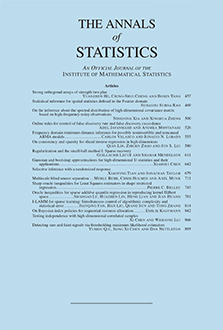Abstract
Chen and Cheng [Ann. Statist. 34 (2006) 546–558] discussed the method of doubling for constructing two-level fractional factorial designs. They showed that for 9N/32≤n≤5N/16, all minimum aberration designs with N runs and n factors are projections of the maximal design with 5N/16 factors which is constructed by repeatedly doubling the 25−1 design defined by I=A B C D E. This paper develops a general complementary design theory for doubling. For any design obtained by repeated doubling, general identities are established to link the wordlength patterns of each pair of complementary projection designs. A rule is developed for choosing minimum aberration projection designs from the maximal design with 5N/16 factors. It is further shown that for 17N/64≤n≤5N/16, all minimum aberration designs with N runs and n factors are projections of the maximal design with N runs and 5N/16 factors.
Citation
Hongquan Xu. Ching-Shui Cheng. "A complementary design theory for doubling." Ann. Statist. 36 (1) 445 - 457, February 2008. https://doi.org/10.1214/009005360700000712
Information





